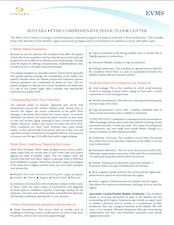What is endometriosis?
Endometriosis is when endometrial glands from the lining of the uterus are present outside the uterus. This can happen when cells travel through your fallopian tube and into your abdomen during your menstrual cycle. If your body is unable to clear these cell, the cells may persist and develop into endometriosis. This process can cause abnormal scar tissue formation in the pelvis.
What kind of symptoms do patients with endometriosis have?
Patients with endometriosis often experience pain with their menstrual cycles. Endometriosis can lead to infertility in some patients. Some patients may also experience pain with intercourse, pain with bowel movements, or urinary problems.
Can I have inherited endometriosis from someone in my family?
If someone on your immediate family has been diagnosed with endometriosis then you may have a 7 times increase risk of having endometriosis. Although we know that there is a genetic aspect of endometriosis the specific cause or causes have not been identified.
How do I know if I have endometriosis?
The only way to diagnosis endometriosis is at the time of surgery although your doctor may suspect that you have endometriosis and start treatment. At the time of surgery your doctor may take tissue to be examined under the microscope. Sometimes the doctor may see area that look like endometriosis but the pathologist cannot identify it under the microscope.
Are there any tests that my doctor may order to confirm that I have endometriosis?
Currently there are no blood test that can confirm the diagnosis of endometriosis. Some imaging studies like vaginal ultrasound or MRI may find areas that are suspicious for endometriosis but surgery is still the best way to confirm the diagnosis of endometriosis.
How is endometriosis treated?
Endometriosis is typically treated with medications and in certain instances surgery. Since we believe that abnormal inflammation plays a key role in the disease, anti-inflammatory medication like ibuprofen may be used. Hormonal medications are also very effective in treating the symptoms of endometriosis. There are also some medications not approved for the treatment of endometriosis but have been found to be helpful. There are also non-hormonal medication that may be useful for chronic pain with endometriosis. These medications work by targeting nerve cells and are commonly used for depression and nerve pain. A list of these medications and the role of surgery can be found below.
What medications are available for the treatment of endometriosis?
- OCP’s (birth control pills)
- NSAIS’s (ibuprofen or Celebrex)
- Depo Lupron
- Depo Provera
- Aromatase Inhibitors
- Levonorgesterol IUD (Mirena)
- Anti-Depressants (Zoloft, Celexa, Lexapro, Cymbalta, Pristique)
- Neurontin
What is the role of surgery in the treatment of endometriosis?
There are two main ways that surgery is used in the management of endometriosis. The first role of surgery is to inspect the pelvis to see if endometriosis may be the cause of painful periods in patients that have failed medical therapy or have an exam with abnormalities. Your fallopian tubes can also be examined at the time of surgery to see if endometriosis may be the cause of blockage if infertility is a concern. The second role of surgery is remove or destroy and tissue that is suspicious for endometriosis at the time of surgery.
Can endometriosis involve other organs of my body?
Endometriosis has been found in many different part of the body but mostly affects those organs in the pelvis. Endometriosis is most commonly found behind the uterus and along the side of the pelvis where the ovary is located. The nerve fibers that provide sensation to the pelvis are located in this area and are thought to play a major role in the symptoms of endometriosis. There may be significant nerve damage or a portion of these nerves need to be removed. These may help with pain but sometimes the pain may recur.
It may involve the rectum, bowel, bladder and rarely the ureter (the tube that connects the kidney to the bladder. When these organs are involved the endometriosis can usually be “shaved” from these organs. Rarely the endometriosis extends deep into the tissue and a portion of the organ may need to be removed.
How much of the endometriosis is removed at the time of surgery?
The goal of surgery is to remove diseased tissue that may be the cause of the symptoms. Endometriosis can involve the nerves that supply the bladder, rectum and vagina. Endometriosis tissue may be left behind to help preserve some of these nerves and hopefully their function. Endometriosis may cause irreversible damage to some of these nerves and may continue to cause pain even if all of the endometriosis is removed. The decision to remove all of the endometriosis or leave some of the tissue is made at the time of surgery. An open conversation about your concerns and wishes with the surgeon can help determine that decision.
What are some the complications associated with surgery for endometriosis?
Risk of anesthesia, DVT, PE, MI, CVA, and possible death. These complications are related to the health of the patient and are very low. There is a risk of major vessel injury, possible laparotomy, possible bowel injury and possible need for repair which may include bowel resection. Although most of these complications are not common the severity of your disease may change your risk.
Possible urinary injury, urinary retention, need for prolonged catheterization, need for ureteral stents or nephrostomy tube, fistula (hole between bladder and vagina) formation and possible need for repair. These types of injuries may require additional surgeries.



